
Velella is a monospecific genus of hydrozoa in the Porpitidae family. Its only known species is Velella velella, a cosmopolitan free-floating hydrozoan that lives on the surface of the open ocean. It is commonly known by the names sea raft, by-the-wind sailor, purple sail, little sail, or simply Velella.

Hydractinia echinata is a colonial marine hydroid which is often found growing on dead, hermit-crabbed shells of marine gastropod species. This hydroid species is also commonly known as snail fur, a name which refers to the furry appearance that the hydroids give to a shell.
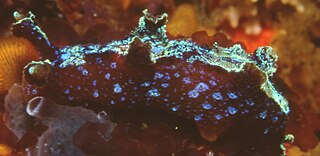
Notobryon wardi, the iridescent nudibranch, is a species of scyllid nudibranch, and is found in South Africa. It is a marine gastropod mollusc in the family Scyllaeidae.

Corynactis annulata, or the strawberry anemone, is a bright pink colonial anthozoan similar in body form to sea anemones and scleractinian stony corals. This species is a solitary animal of the order Corallimorpharia.
Bougainvillia britannica is a marine invertebrate, a species of hydroid in the suborder Anthomedusae.
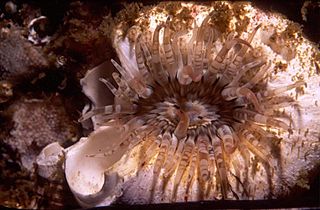
The ring-tentacle anemone is a species of sea anemone in the family Isanthidae.

Tubularia indivisa is a species of large hydroid discovered in 1758. T. Indivisa is observed to have around 40 oral tentacles surrounded by 20-30 larger tentacles. This outer ring of larger tentacles are paler and longer than the inner ring of oral tentacles. The tough and yellow unbranched stems are clustered together and fuse at the base of the colony. The color of the single polyp itself can range from a pale pink to a red and in spring (mainly), red or pink gonotheca grow between the inner set of oral tentacles. The gonotheca can be described as "part of hydroid producing gametes where eggs are often incubated until the larva is released". The polyps are observed with a conical or flask shape and present only in spring, with the diameter of the polyp and tentacles being around 15mm in length and the overall height observed of the entire organism ranging from 100-150mm.
Coryne muscoides is a species of athecate hydroid belonging to the family Corynidae. It is a species of the north-eastern Atlantic Ocean and the Mediterranean Sea. This is a many-branched rose-coloured hydroid, up to 15 cm tall with distinctive ringed stems and branches. Each branch ends with a cluster of knobbed tentacles. It can be found in deep rock pools and attached to large seaweeds.

Eudendrium ramosum, sometimes known as the tree hydroid, is a marine species of cnidaria, a hydroid (Hydrozoa) in the family Eudendriidae of the order Anthoathecata.

Obelia longissima is a colonial species of hydrozoan in the order Leptomedusae. Its hydroid form grows as feathery stems resembling seaweed from a basal stolon. It is found in many temperate and cold seas world-wide but is absent from the tropics.

Carybdea murrayana Haeckel, 1880, also previously known as Carybdea branchi, the South African box jellyfish, is a venomous species of cnidarian, in the small family Carybdeidae within the class Cubozoa.

The tubular sponge hydroid is a species of hydroid cnidarian. It is a member of the family Tubulariidae. These animals usually grow embedded in sponges.

Stylaster nobilis, the noble coral, is a branching colonial hydroid in the family Stylasteridae.

Thuiaria articulata, the jointed hydroid or sea spleenwort, is a branching colonial hydroid in the family Sertulariidae.
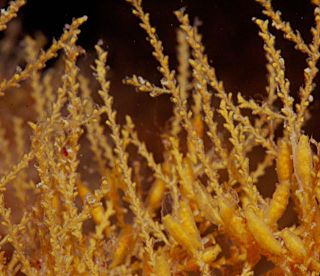
The planar hydroid is a branching colonial hydroid in the family Sertulariidae.

Sabella spallanzanii is a species of marine polychaete worms in the family Sabellidae. Common names include the Mediterranean fanworm, the feather duster worm, the European fan worm and the pencil worm. It is native to shallow waters in the northeastern Atlantic Ocean and the Mediterranean Sea. It has spread to various other parts of the world and is included on the Global Invasive Species Database.
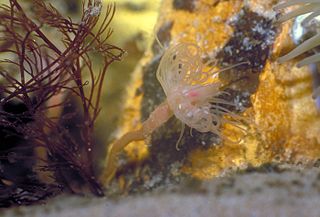
Ectopleura larynx, or ringed tubularia, is a hydroid in the family Tubulariidae.

Halecium muricatum, commonly known as the sea hedgehog hydroid, is a species of hydrozoan in the family Haleciidae. It occurs mainly in arctic and northern temperate waters, in both the Atlantic and Pacific Oceans.

Halecium halecinum, commonly known as the herring-bone hydroid, is a species of hydrozoan in the family Haleciidae. It is native to the eastern Atlantic Ocean, the western Atlantic Ocean and the eastern Pacific Ocean.
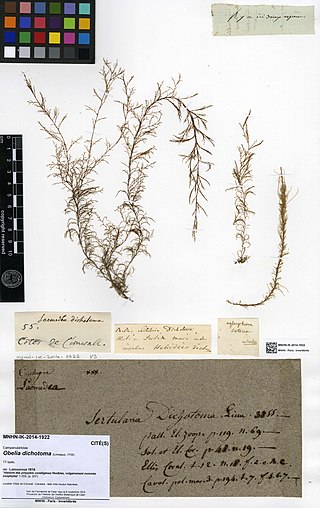
Obelia dichotoma is a broadly distributed, mainly marine but sometimes freshwater, colonial hydrozoan in the order Leptothecata that forms regular branching stems and a distinctive hydrotheca. O. dichotoma can be found in climates from the arctic to the tropics in protected waters such as marches and creeks but not near open coasts like beaches in depths up to 250m. O. dichotoma uses asexual and sexual reproduction and feeds on mainly zooplankton and fecal pellets. Obelia dichotoma has a complex relationship with the ecosystem and many economic systems.


















